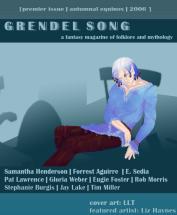“Treason Is” by Forrest Aguirre
“Munashe and the Spirits” by E. Sedia
“Crow” by Pat Lawrence
“The Branches of the Tree” by Gloria Weber
“Shim Chung the Lotus Queen” by Eugie Foster
“Ivy and Thorn” by Stephanie Burgis
“The Best of Men, The Best of Times” by Jay Lake
GrendelSong, a new fantasy magazine of folklore and mythology, gets off to a really strong start. The offerings in its premiere issue are diverse enough to appeal to many interests, but have common roots.
“Grandmother” by Samantha Henderson is a retelling of “Little Red Riding Hood.” Only in this version, the wolf is young and guileless and Red isn’t so little. Told from the wolf’s point of view, it’s clear that the relationship between man and wolf isn’t as cut and dried as one might expect. Henderson wraps descriptive language around bits of the familiar like a grandmother, a red hood, a wolf, and familiar phrases and flips the perspective to create something different. “Grandmother” is short, bittersweet and well worth the read.
“Treason Is” by Forrest Aguirre may remind you of the Man in the Iron Mask by Alexandre Dumas. Unlike that tale, where good ultimately triumphs over evil, there is no clear victory, just a hint that the cycle of violence is never ending. The protagonist is a hollow man, partially because of his situation, and partially because in the end, he is of no consequence. This story is all about his crime and its consequence. The plot of “Treason Is” really didn’t appeal to this reviewer, but it may appeal to you. Aquirre’s language is vivid and the story is well worth reading just to see the word “etiolated” properly used in a sentence.
“Munashe and the Spirits” by E. Sedia could take place just about any time; the only indications that the story is contemporary are that several characters die of AIDS and a ghost Cadillac makes an appearance. The story centers on Munashe who has been forced into servitude after he lets his mother die. He must find a way to heal his captor or toil away for her forever. It’s a bitter tale, very reminiscent of a Grimm fairytale. However, what “Munashe and the Spirits” really connects to is the African storytelling tradition that thrived for generations due to the lack of written material. Folktales were used to prepare young people for life and contained many lessons. By the end, Munashe has indeed learned something; only the reader can decide if it was the lesson he was intended to learn.
“Crow” by Pat Lawrence shows that there really is somebody for everybody. An old man walks through the suburbs early in the morning, just before dawn. He prefers the quiet and the absence of people. During his jaunts, he begins to encounter another individual that just might break his solitude. “Crow” is a fast read that touches on the melancholy but never quite slides into it. Take the time to savor it.
In “The Branches of the Tree” by Gloria Weber, the protagonist, Rensi, returns to his mother’s homeland, hoping to glimpse the familiar, but instead finds it drenched in horror and blood. There is no place left for him, either in his past or his present. “The Branches of the Tree” is a harsh tale that centers on what can happen when one culture conquers another. Although I didn’t care for it, I understand its place. Just like a Holocaust story, some tales need to be told simply to prevent future generations from repeating the mistakes of the past.
“Shim Chung the Lotus Queen” by Eugie Foster is based on a traditional Korean fairy tale that explores loyalty, selflessness, and virtue. Shim Chung and her blind, old father are poor, but happy. A chance encounter with a messenger of the gods provides the father with an opportunity to regain his sight. Shim Chum sacrifices herself in order to make that possibility a reality. To find out what sacrifice Shim Chung is willing to make and what the outcome of her sacrifice is, read the story. Author Foster lends her own twist to this Korean version of the Cinderella story. Strong characterization means you will definitely connect with Shim Chung and want to know what happens next.
“Ivy and Thorn” by Stephanie Burgis tells a story in which all that glitters isn’t gold. Seduced away by her fairy lover, Mary Hamilton returns to her husband many months later because she is bearing his child. Her husband allows her to come back and treats her with respect, but he seems to have moved on without her. Others in the household scorn her, both for leaving and daring to return. By the time she returns, Mary has had her fill of life among the glittering throng, where beauty and cruelty go hand in hand. With priorities firmly in place, Mary plans to raise her child and manage her husband’s household even as her fairy lover threatens to steal her back. Whether or not there is a place for Mary in her husband’s life and if it’s really possible to escape from the fae is the heart of the story. Author Burgis does an excellent job crafting Mary’s world, intermingling folklore and British history.
“The Best of Men, The Best of Times” by Jay Lake is a piece of flash fiction that explores the aftermath of the fall of Troy. Broken and bent by ten years of war, the narrator details what remains of the city—its former citizens and its conquerors. Read this to evoke a feeling of hollowness and loss.
